Tribeca Immersive Diary 2022 (Updated 6.20.22)
Our team festival coverage, all in one place

Each year the crop of projects at Tribeca Immersive (formerly Tribeca Storyscapes) set the bar for what’s to be expected from XR artists in the year that follows. This year’s group is no different, with three major categories Main Competition, New Voices, and Best in Season — with the later exhibition only — and four thematic threads tying the 21 projects together.
This year the Festival remains in hybrid mode, with a number of the projects accessible from home including a good number of the New Voices selections.
What follows is our team’s capsule reviews of the works, and this post will update over time as more reviews are added to the diary.
On-Site reviews: Edward Mylechreest, New York City Correspondent
At Home reviews: Noah Nelson, publisher & podcast host
In addition, podcast interviews with creators and curators, and written Q&A’s round out our coverage. They will be linked here as well.
- Podcast Interview: This Is Not A Ceremony
- Podcast Interview: Tribeca Immersive’s Ana Brzezinska
- Podcast Interviews: Intravene & Mescaform Hill
- Creator Spotlight: Q&A Interviews with Five Projects
Reviews (Alpha By Project)
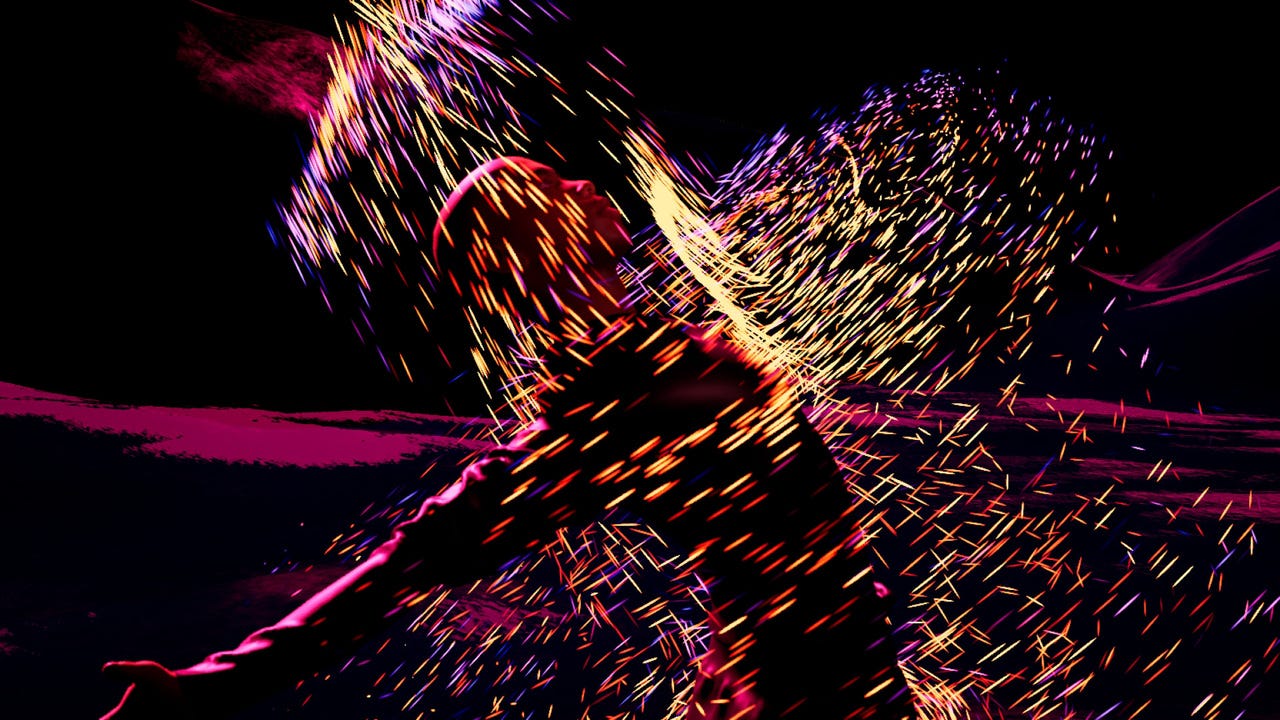
BLACK MOVEMENT LIBRARY — MOVEMENT PORTRAITS
LaJuné McMillian; Brooklyn Public Library et. Al.
17 minutes, VR (3DoF), On-Site & Museum of Other Realities
A vertical slice of a larger scale project, the portraits here take the form of a series of vignettes across both projected film interviews and 3D animations. Multiple dancers are interviewed, their dance movements transliterated into the Unreal Engine using motion capture. After meeting the dancers via video interview, their words continue over a game engine rendered version of their performance.
The results exhibit some of the glitching endemic to certain methods of performance capture, but what’s presented feels like it leans into that glitching as an aesthetic choice. When coupled with the interviews the portraits serve as an extension of the expressions of the various subjects, and not as an attempt to create an authoritative digital representation of their selves.
The movement portraits exist as part of the overall Black Movement Library that McMillian is creating: a library for “activists, performers & artists to create diverse XR projects, a space to research how and why we move, and an archive of Black existence.” The focus is not only on archiving work from performers, but creating tools and performances. In an era when machine learning program often overlook Black voices and identities, this is a project that appears set to build a foundation for Black representation in the digital arts.
That it is rooted in the dance and movement is also apt as a future bulwark against unauthorized appropriation. Those who are dialed in to the dance and game communities know that there was no small controversy, and a number of lawsuits, over the use of choreographers’ signature moves as purchasable emotes in popular games. While the practice of crediting and compensating dancers in these digital works has evolved since the initial issues, the larger questions about who digitizes movement, who can access it, and whose stories get told in these spaces is an ongoing cultural discussion.
Which is what makes the whole of the Black Movement Library project so compelling, even if a few of the vignettes in this glimpse of the collection at times gave me a little spell of sim woozies thanks to some parallax scrolling issues with the moving camera. Nothing too extreme, but future versions might do well to ditch the moving camera and let the audience pick their vantage point. — Noah Nelson
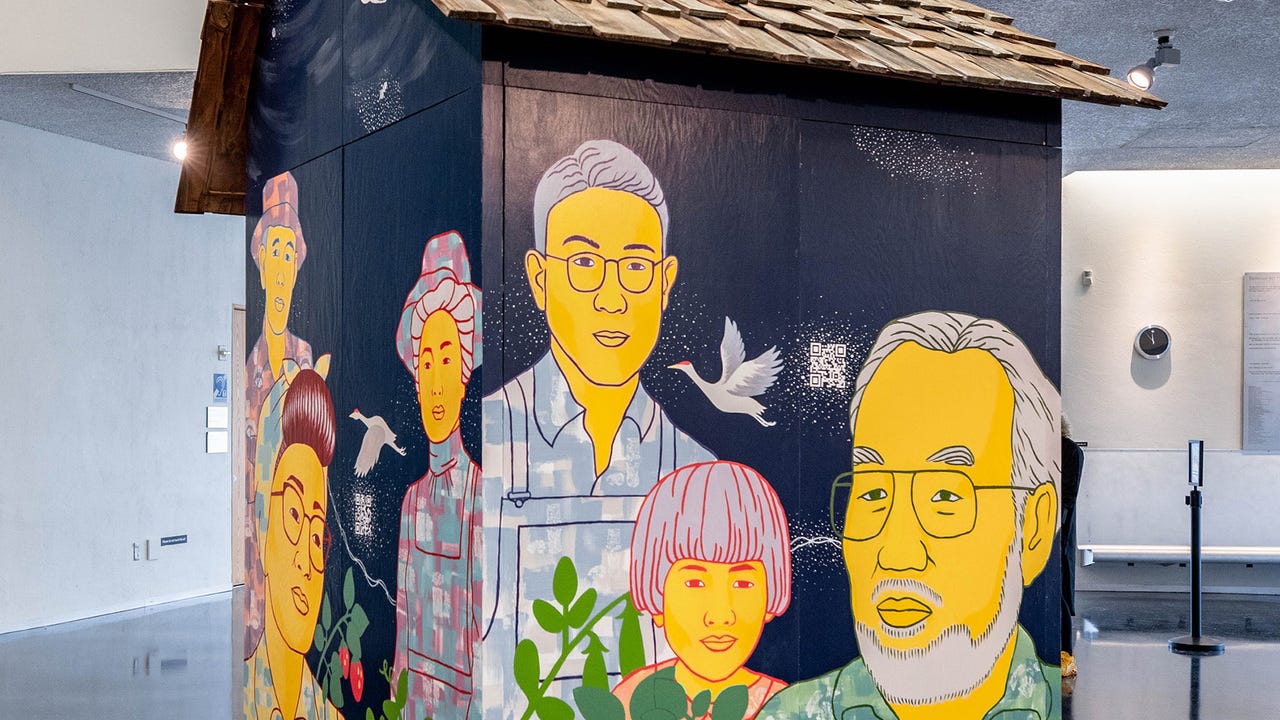
EMERGING RADIANCE: HONORING THE NIKKEI FARMERS OF BELLEVUETani Ikeda; Meta Open Arts
3 Minutes, Art Installation + AR filter, On-Site & Museum of Other Realities
Museum of Other Realities Edition
Three hand-painted murals depicting Toshio Ito, Rae Matsuoka Takekawa, and Mitsuko Hashiguchi, who survived the United States World War II incarceration camps after being removed from the farming homelands in Washington come alive through animation in this installation which can be listed both in New York City and in the virtual galleries of the Museum of Other Realities.
In person the installation relies on Spark AR Instagram filters to unlock the animation on a mobile device when held up to the murals. In VR this effect is triggered by standing in a specific spot. The clips involved on display in the MOR are brief, with the whole triptych only lasting a cumulative three minutes. I must confess that I found myself wanting more in the moment. Not in terms of spectacle, but just more time with the subjects themselves. The act of “unlocking” a static image is undoubtedly cool in and of itself, yet the subject matter at hand feels like it calls for more than a glancing encounter with the lives of these survivors. Perhaps the in-person version goes longer, although the Tribeca website does not suggest this, or perhaps there’s more in the pipeline.
It’s somewhat paradoxical. On their own the murals, which are displayed on small structure evocative of a workhouse on a farm, stand as a testament to the Nikkei famers of the region. The opening of the AR filters, however, sparks additional curiosity and without some kind of call to action in the flow of the digital content or a way to unlock more starts to feel like a missed opportunity instead of a nice bonus on the physical work itself. The good news about digital work is that it is nearly endlessly extendable. Hopefully there’s some funds out there to expand this project. — Noah Nelson
On-Site Installation
As I look at the three tall murals on the wall, the elderly woman in one of them turns to face me, and I hear her recollections of a troubling tale of the American story.
A short experience, the murals come to life thanks to an Instagram filter tracking QR codes, and each one depicts one of the Japanese Americans who were trapped in the California internment camps after the bombing of Pearl Harbor. Its a relatively unknown part of the World War II story, but one that has had an impact on generations of citizens who are finally getting their own stories told. Hearing the words of the interviewees,Toshio Ito, Rae Matsuoka Takekawa, and Mitsuko Hashiguchi be “spoken” by the artists depictions of them is truly touching. These handpainted murals will permanently reside in Bellevue once this Tribeca Festival concludes.
This simple piece is a wonderful way to remind us of our past, through engaging with art work in a way that quite literally tells an authentic story of those who lived our history. As the barrier to tech entry gets lower and lower, I hope that more companies will endeavor to create pieces like this which in their simplicity can still have meaningful impact.— Edward Mylechreest
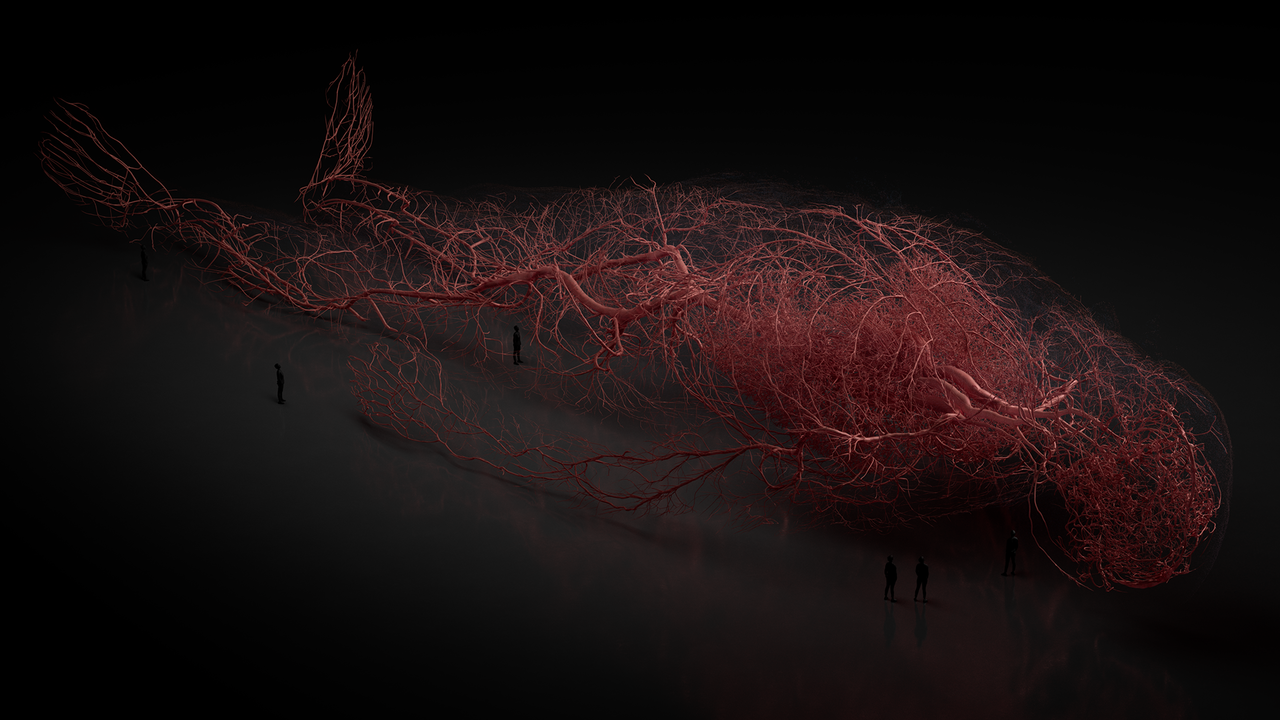
EVOLVERNicole Shanahan (Bia-Echo), Edward R. Pressman & Sam Pressman (Pressman Film), Terrence Malick (TF Malick Productions), Antoine Cayrol (Atlas V), Mike Jones (Marshmallow Laser Feast)
24 min, VR (6Dof), On-Site Installation
I walk far away from the rest of the Tribeca festival, and find a building with blacked out windows and doors. I am ushered through to a gallery, a waiting area that is still in almost total darkness. Along the walls I can barely make out strange paintings and images of what look like body parts. Only they don’t seem quite right, and they flicker every moment or two. A larger screen holds an impressive display of a tree made out of thousands of small grains which seem to twist and move as the tree grows, dies and grows again. As my eyes begin to adjust to the darkness, we are called through for our experience to begin.
Inside a cylindrical room, lined with dark curtains, we are invited to lie down on black round bean bag chairs and look up into the roof. Headphones are placed on our heads, and a meditation on life begins (narrated by Cate Blanchett, of all voices). As Earth, matter and creation are discussed, the sound design places me in a place of zen. This dreamlike stupor is clearly the goal, as we are then moved to the actual presentation of Evolver.
This VR creation allows multiple users to exist in the same space at once, with six other inhabitants in my session. Other users appear as glowing dots, outlined by their head and hands, to ensure no collisions, but a team of guardians are on hand to watch over our every move.
Inside the simulation, we witness a breath. Thousands of tiny grains fly around us, these small atom-like dots respond to our presence. They gradually begin to build and combine, forming larger and larger clusters. A shade of red begins to take over, and the blood stream of veins begins to appear around us. Darkness over shadows me, and as I walk around trying to work out where I am, I realize that the thousands of pieces have formed into bone material. I was stood inside the resting skull of a human. I am able to walk through the body, following down to the ribs and seeing the lungs and nerves continue to pulsate in this gigantic being. I find an odd moment of closeness as I draw my hand against the skeletal hand of this unnamed creature. It is a truly stunning presentation, one that feels almost sacred in its delivery of spectacle.
This piece is astonishing in its scale, in a way that made this reviewer feel immensely small. While there is no direct narrative per se, the piece reflects whatever questions it brings to the users mind. What are we in the scale of all creation? What part do we have to play in this universe? What is life?
Existential and exceptional in nature, Evolver is an inward look at our very beings that left me with much to consider and even more to ponder. This is the VR that people have imagined for so long, used in a way to take us beyond our imagining, to help us further connect with ourselves. Astonishing.
— Edward Mylechreest
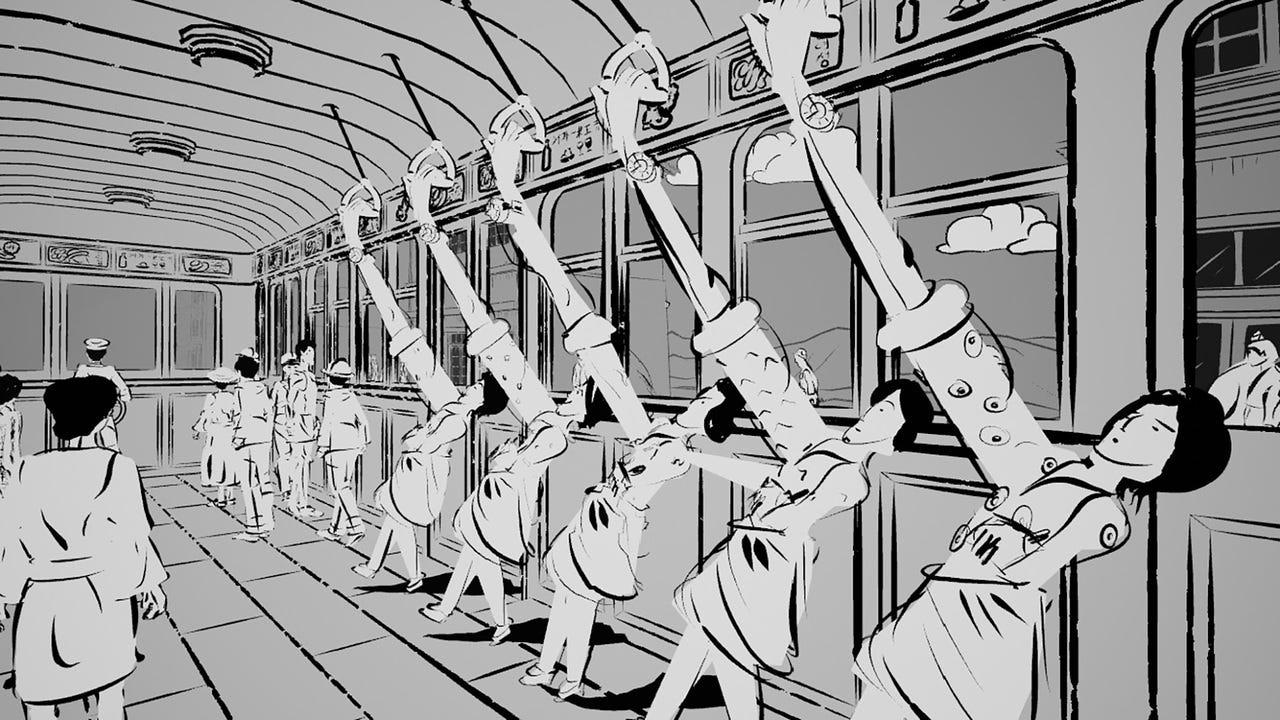
KUBO WALKS THE CITYHayoun Kwon; Innerspace VR
20 min; VR (6DoF); On-Site
I walk through the streets of Seoul, following the voice of the titular Kubo. It is 1934, and the city is under Japanese occupation.
The art style is truly stunning, with the entire world being a black and white hand painted scene. The models are animated in such a way as to keep them looking like 2D images, even as I walk in and around the city. Invited to step inside a tram, the world passes by as the other commuters around me move in time to the atmospheric music.
Unfortunately, a host of tech issues really took away from this experience for me. I had near constant rendering issues, as turning my head at any speed at all ended with me having a total black out in front of me. Sound issues were rampant as well, taking away from the intimacy of the story, and the fidelity of the main narration felt lacking to my ears. I also found the “next step” procedure to be somewhat lacking, with white pools appearing where you are meant to stand when the story wants to progress. These seemed less than intuitive to me, with little guidance or preparation as to the appearance of a new stop. All of this lead me to becoming less engaged with the world and story, instead being more preoccupied by the technical issues.
If time had allowed, I would have loved to experience this piece again to see if these tech issues were a one off, but alas it was not to be. This plays into the difficulty of producing immersive VR work, in that audiences can only experience a piece for the first time once, and if that experience isn’t quite “ready” it can leave an unfortunate lasting impression.— Edward Mylechreest
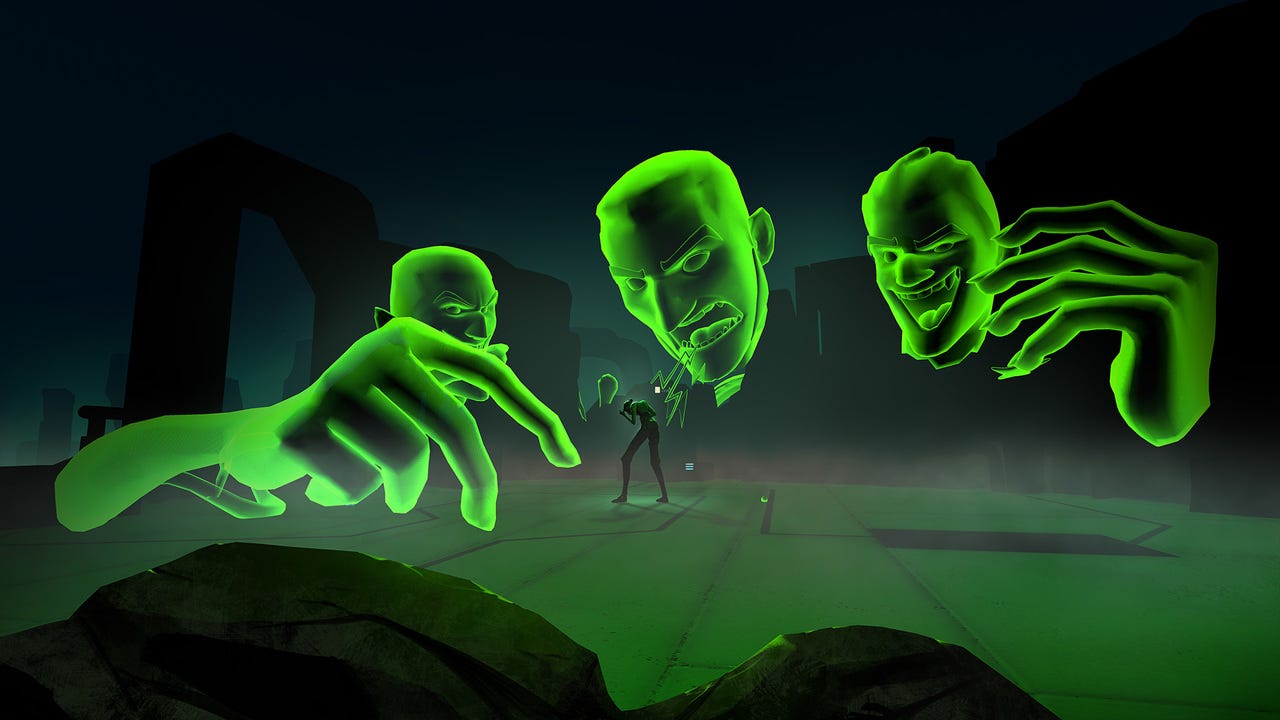
IAGO: THE GREEN EYED MONSTERJosh Nelson Youssef, Camila Marturano, Julian Dorado; Juvee Productions, 3Dar, Verizon
6 mins, AR, On-Site & Mobile Devices
On-Site
Several small dioramas sit expectantly, as bright green cables weave around them to a luminous sign: Iago. This is certainly one of the most arresting sights here on site, and had a near constant crowd around taking pictures during the time I was there. The diorama has a neon green target sign in the center, inviting the audience to accurately use the iPad nearby to correctly line up the experience. What awaits is a real treat.
Reimagined as a female lieutenant in some futuristic war, we witness the schemes and the rise of the classic Shakespearean villain Iago from Othello. As a rock opera.
This short piece is a great use of augmented reality, with a kickass song to boot, using some of the original Shakespeare text as basis for the lyrics. Over the course of the song, we witness Iago’s jealousy literally taking her over, as she eventually becomes the titular Shakespeare creation, the Green Eyed Monster.
The AR is well done, with great flexibility for “imaginative” camerawork by this user. The actual line up to the in-person diorama is not quite as accurate as it could have been, but the inclusion of a set for the experience to take part on is a nice addition. The song has stayed in my head ever since, and this was a great experience which I enjoyed thoroughly.
Just please don’t be too jealous of me. — Edward Mylechreest
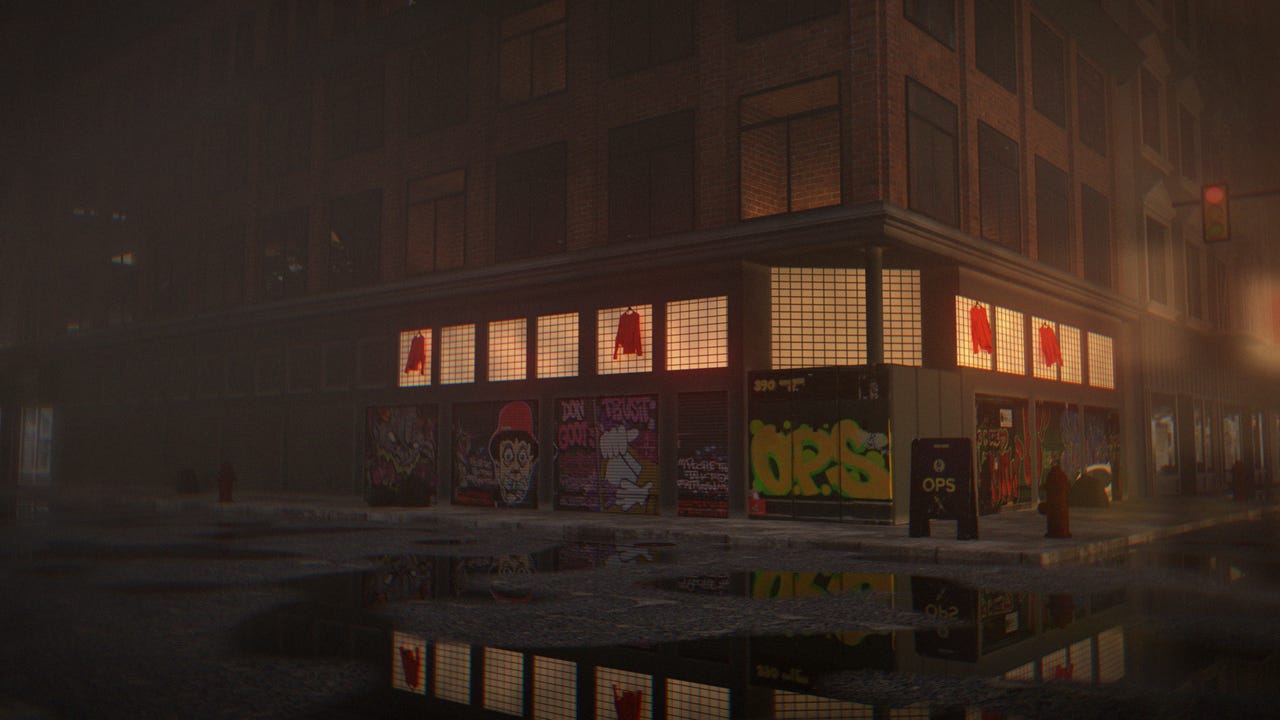
INTRAVENE — EPISODE ONE: BENZOS
DARKFIELD, Crackdown, Brenda Longfellow
25 minutes, Audio, On-Site
At Home Edition (Releasing Soon)
The latest from DARKFIELD is a major departure in content, if not in form, from the pioneering spatial audio storytellers. This time out instead of creating a fictional storyscape the team has partnered with documentarian Brenda Longfellow and host of the Crackdown podcast Garth Mullins to create an immersive audio docudrama.
Mullins podcast has been documenting the overdose crisis in Vancouver for three years now. In short: a tainted drug supply has been killing users at alarming rates, and one community response has been the development of Overdose Prevention Sites where staff is on hand to intervene in the case of an emergency. Intravene is set, for the most part, inside an OPS with the audience put into the point of view of a drug user who will experience an overdose. It is, to say the least, an aurally intense experience.
DARKFIELD uses location sound and interviews provided by Mullins and Longfellow to create an audio scape that is at times narrowly hyperreal and serenely surreal. The serenity comes, somewhat ironically, during the moments designed to simulate an overdose. Voices distort as if heard from underwater and then we find ourselves in a kind of limbo, waiting for our number to be called.
For a piece that is pure audio, there is something intensely visual about Intravene. This tends to be true of much of DARKFIELD’s work, but here the use of on location documentary sound heightens the sense of presence. Perhaps it is the way that a real location adds tiny bits of sensory information to the audio landscape, or the contrast between the OPS and the invented soundscape. Whatever the magic is, it’s working.
Working too is the urgency with which the storytelling conveys both the breadth of the overdose crisis and the ever shifting landscape that activists face while trying to prevent tragedy. There is an immediacy to the piece that Mullins’ deep ties to the community provides, and it parlays itself into a depth of empathy for those who are both scourged by the tainted supply and the activists who are trying to keep the worst effects at bay.
Benzos is the first of two episodes in this format, and there is additional material on the Crackdown podcast drawn from the production of Intravene. All of which will be available to the public soon. Not easy material to sit with, but well worth the time. — Noah Nelson
On-Site Edition
I walk into a overdose prevention center, surrounded by helpful posters and pamphlets for would be users to peruse as they await their calltime. I am invited to sit at my desk, and find a mirror staring back at me with a syringe bin to my left. I place my headphones over my ears, and am instructed to close my eyes, and without warning, the entire world goes black.
Darkfield have once again produced an impressive audio drama that immediately immerses the audience into the world of their latest piece, Intravene. This 25 minute experience tracks the day to day goings on within this unique space, where users are able to take various drugs while under the supervision of trained nurses and volunteers. Hearing the interviews of those who go in and out of the doors of this Vancouver center is intriguing, informative and heartbreaking all at the same time.
Occasional subwoofer hits help to punctuate the story that is being told, leading to a spike in adrenaline in this audience member. The room really has gone pitch black for the duration of the piece. I risk a peek, and I can not see my hands at all in front of me. The isolation of senses is alarming at first, but eventually gives a sense of waiting or purgatory which the drama itself leans upon. While certainly impactful anywhere, being able to experience this piece in person in this curated space really added to the visceral reaction I felt to listening to this impressive piece of audio storytelling.
Hardhitting and provocative with a lasting impression, this is a stunning piece of art.— Edward Mylechreest
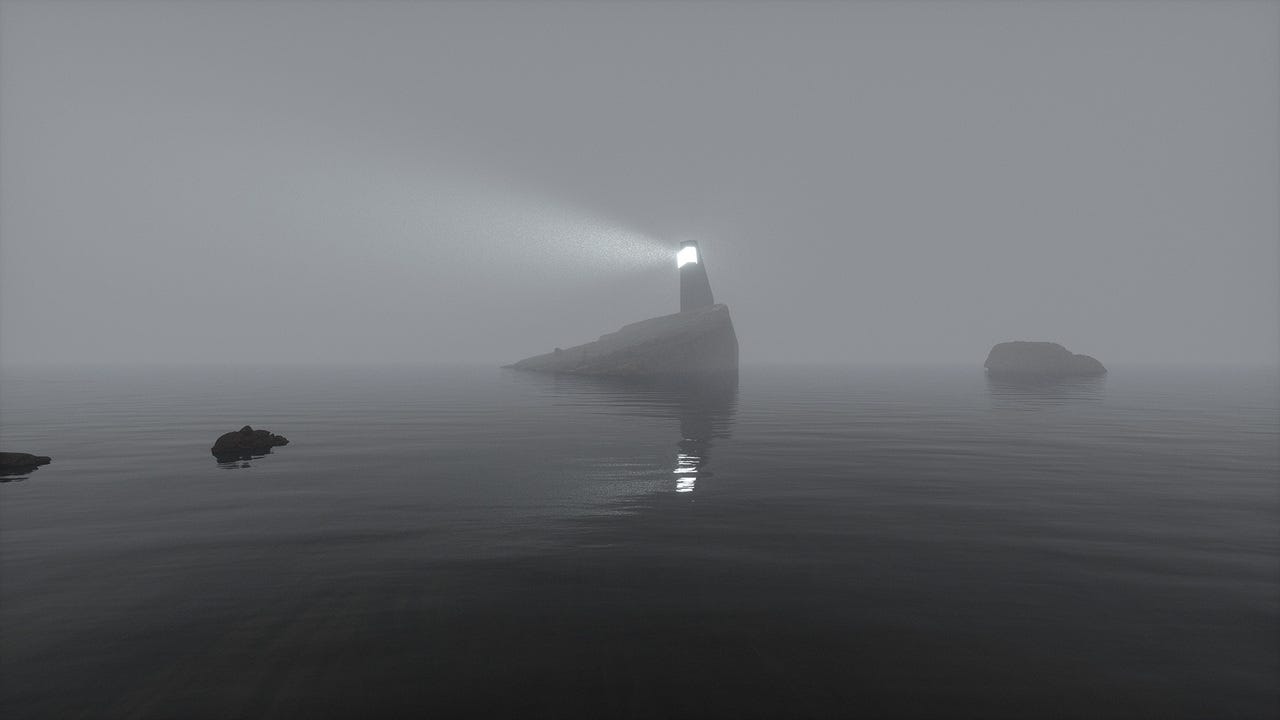
LIMBOTOPIA
Wen-Yee Hsieh
25 min, VR (3Dof), Museum of Other Realities, Oculus TV
Get No Proscenium’s stories in your inbox
Join Medium for free to get updates from this writer.
SubscribeSubscribe
A slow, meditative burn, Limbotopia is one of of those pieces that is easy to bounce off of if you’re not in a headspace receptive to a meditative vibe. I know I did at first, but was glad I came back to experience the full run of the short.
A series of vignettes that are tied together as a journey through a largely monochromatic landscape (“largely” because of the occasional use of color for effect), Limbotopia plays out like a journey through an extra-dimensional plane. Sometimes unsettling in the “uncanny” sense, sometimes beautiful, the creative team really nails the “limbo” part of Limbotopia with the vibe. And indeed, vibe is seemingly the whole point here.
My first dip in lasted maybe all of ninety seconds, as I wasn’t in a mental place where I wanted to settle in for a slow paced on-rails experience. My second dip still had me resisting the flow for the first couple of minutes, as the imagery of empty cityscapes and abandoned villages managed to both set me on edge and, thanks to the pace, test my patience. Yet pushing through was worth it, as the flow of the piece starts to work its mojo and that unsettling feeling morphs from a bug into a feature.
There’s a kind of edge walking I’ve had in certain branches of meditative experiences, where you’re tiptoeing around a psychic manifestation of the abyss. It’s not exactly pleasant, but it also manages to be oddly life affirming. The emotional equivalent of a cold plunge. That’s what I took from my time in Limbotopia. — Noah Nelson
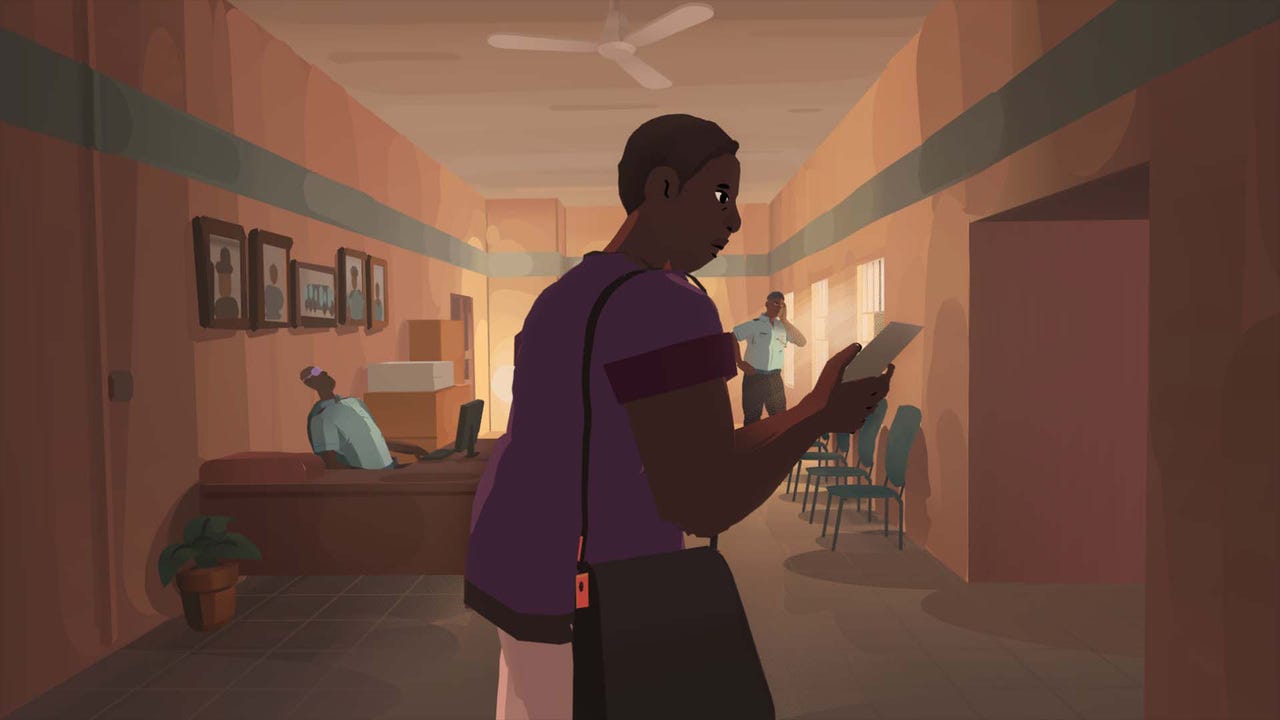
MESCAFORM HILL: THE MISSING FIVE
Adam Madojemu, Edward Madojemu; Meta
18 min, VR (3DoF); Museum of Other Realities, Oculus TV
Artist Edward Madojemu has a knack for bringing the pop of the comic book form to virtual reality. His student work, Dami & Falian: How Was Your Day was itself a revelation back in 2019 when it was being shared with members of the VR community in Vancouver and showed just how much immersive storytelling techniques could open up the possibilities of sequential storytelling.
The story of Mescaform Hill grows out of a webcomic that Madojemu developed with his brother Adam, set in an African town reminiscent of the one they grew up in. This particular tale from the world they created focuses on two missing persons cases that are tied together in an unexpected way. A young Road Safety cadet finds himself swept up in case he’s not supposed to investigate, one that proves there is more going on in Mescaform Hill than he imagined on more than one front. (Excuse the vagueness here, as I’m aiming to preserve a little mystery.)
This latest work, which marks Madojemu’s Tribeca debut, is a production for Oculus TV and focuses on the dynamics within the spatial frame rather than how audience agency can reshape that frame. As such it is not as structurally ambitious as some of the artist’s work, but the limitations of the platform force a focus on character, story, and a more one-to-one translation of the graphic novel form to the spatial stage. As such it serves as a solid introduction to the Madojemus as storytellers, and an excellent reminder of how many different kinds of stories and story forms that VR can support.
As a piece of genre fiction Mescaform Hill shows that the team knows how to walk the tightrope between sociological storytelling that puts characters into dynamic societies from which the plot of the narrative derives and the kind of mythic storytelling that puts an emphasis on the psychological impact of the systems in which the characters live. It’s a balance that many creators reach for, but is difficult to accomplish. Madojemu breathes this stuff. — Noah Nelson
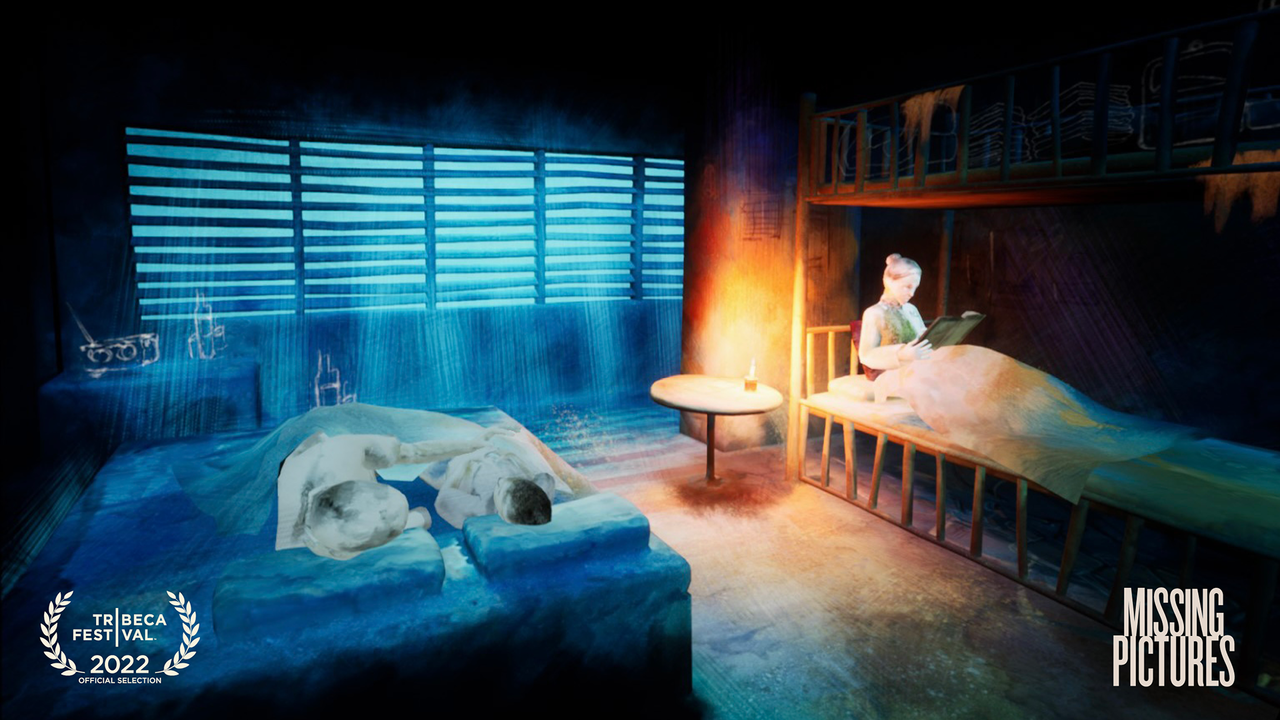
MISSING PICTURES, PARTS 3–5Clément Deneux, Joseph Beauregard;
Atlas V, Arte France, BBC, PTS Taiwan, Serendipity Films, Wild Fang Films, Giioii
56min, VR (3DoF), On-Site
A behind the scene documentary for films that never were, Missing Pictures tells the story behind the stories that are as yet on the cutting room floor for one reason or another. Leading directors, from across the cinematic world, intimately share their thoughts and frustrations with their inability to get their stories made for a whole host of reasons.
Catherine Hardwicke tells of her dream to create a movie adaptation of the Monkey Wrench Gang, a story she grew up reading. She sits at a campfire with her imagined cartoon version of her cast, and through brief glimpses all around me, she relays the eco-action story she wished she could tell. She speaks candidly of her struggles with Hollywood, getting her work seen and notice as a female in the city, but leaves on a hopeful note as she speaks of some of the other women who have been able to direct work since her debut.
In Father is Gone, Lee Myung-Se shares his autobiographical story of an absentee father in 1960’s Korea. The animation style here is very different to the first, as we have moved continent and vision completely. In another time, this would have been the director’s debut, but fate had other plans. I watch as a paper airplane soars and flies away wistfully as Myung-Se debriefs his career and his familial relationships.
Japanese director Naomi Kawase, tells of a coming of age story for a depressed woman in her original story pitch, Oh Debu. In what would have been a deviation from norm, this would have been the first comedy film by the director following their breakout successes.
Listening to creatives discuss their process is always fascinating to me, and this is a wonderful way of ensuring that these pictures aren’t lost forever. Whether this VR production will make these projects more or less likely in the future is as yet unknown, but this wonderful series was a delight to experience. With different artistic visions each time, this series feels fresh with each episode, and gives hope to the other creatives of the world, to know that struggles and challenges are truly universal. Perseverance though is what it takes to create.— Edward Mylechreest
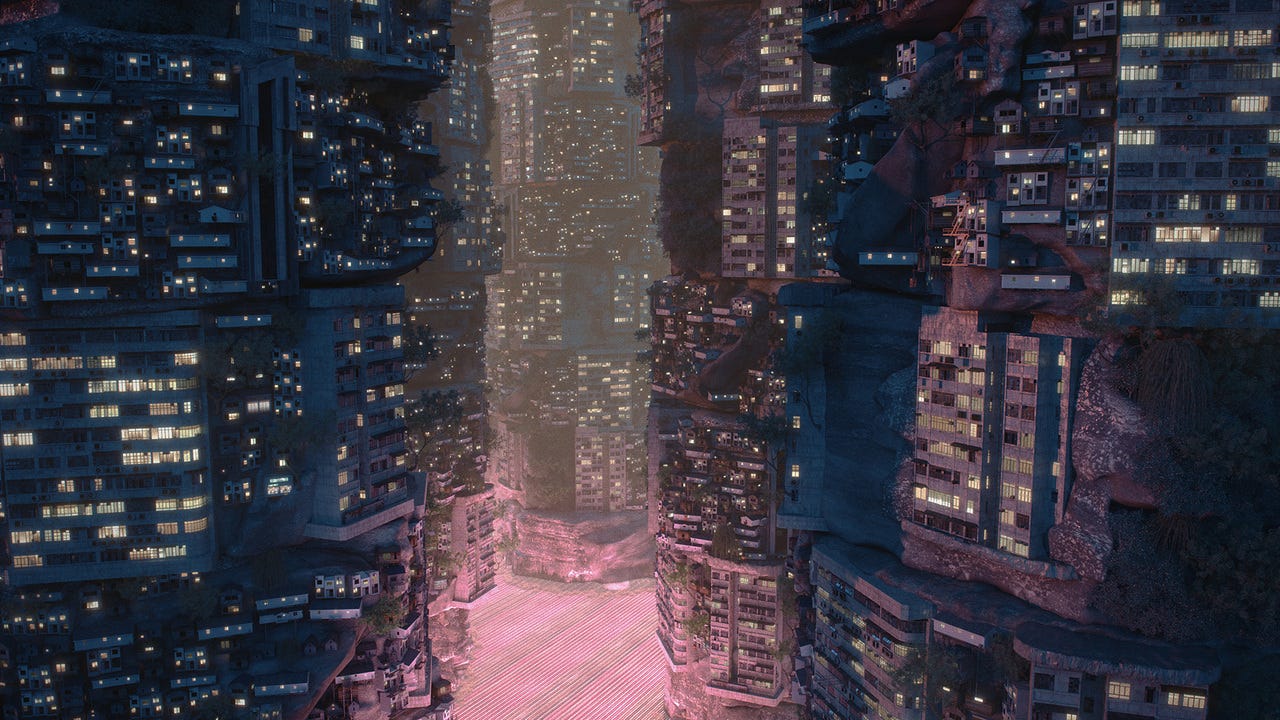
PLANET CITY VRLiam Young; Well Played Studios, HTC Vive Arts
6 mins, VR (6DoF), On-Site & Museum of Other Realities
I watch silently as they begin to arrive. Hundreds, then thousands of people, their small makeshift houseboats heading across the water together. All of them. Uniting. All 10 billion inhabitants of the human race, collecting together in this unique experiment.
Climate Change was ruined our planet, but in Planet City we begin again. Surrounding the exhibit are headpieces representing our ethnic diversity in this future, and in the VR headsets we hear the voice of a child explaining how this all came to pass.
The in progress city looked like a mixture between the RV housing towers of Ready Player One and the neon noir cityscape of Blade Runner. Whilst very beautiful to look at, having been asked to stay in one spot and to just look around, I felt I was in a stunning picture book rather than an actual place. I could appreciate the beauty around me, but ironically enough, never felt the human connection to what I was supposed to be seeing.
A lot of time and effort has gone into the research of this imagined city, what it would take in order for such a place to actually become a reality. How many languages would be spoken, what holidays separated, how many fruit tress would be needed. Facts and figures adorn a wall next to the installation for interested parties to look at, and there is a hefty sized book that is available for perusal (a digital copy also available online). As fascinating as this research may be, the resulting art piece felt like a prelude to the project, rather than a finished meaningful tale, and the information itself doesnt actually appear in the VR experience. Nor do any humanoids, only the architecture that they have created. For all the study, I wanted to see more of what life within this city might have been like from the inside, rather than as an outside observer.
— Edward Mylechreest
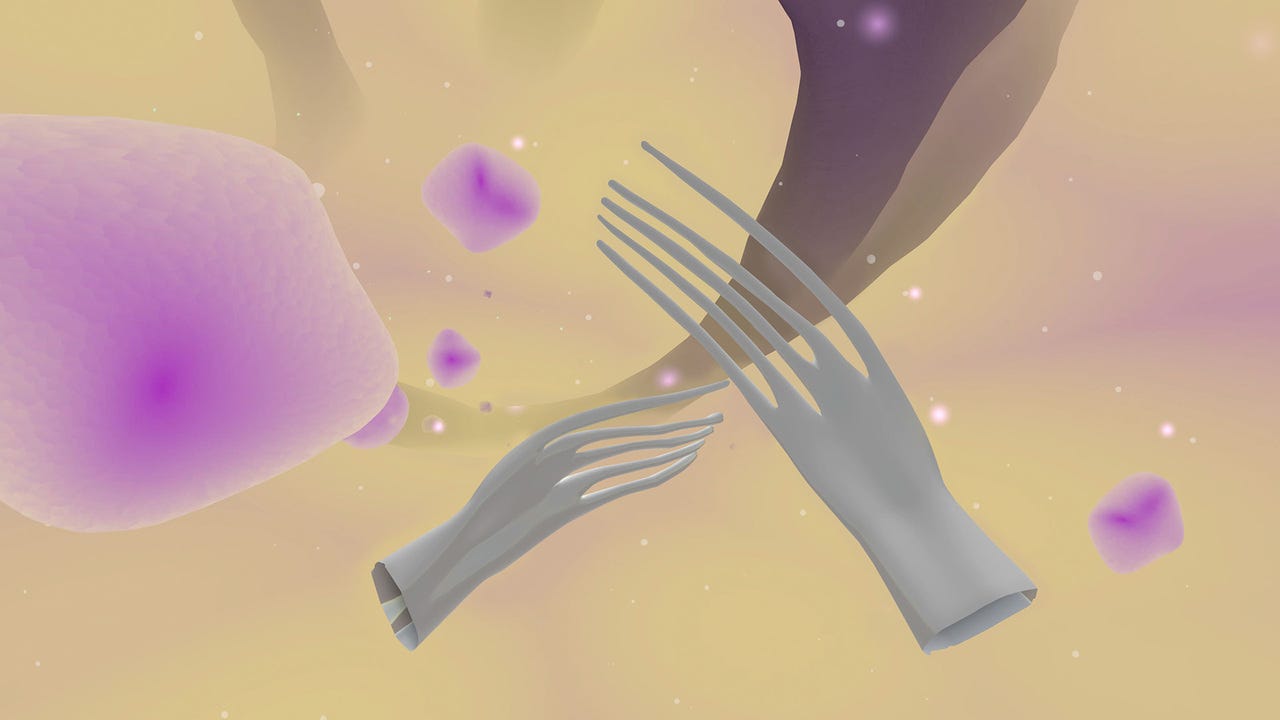
PLASTISAPIENSMiri Chekhanovich, Édith Jorisch, Dpt.; National Film Board of Canada
15 min, VR (6DoF), On-Site
What’s a good VR exhibit without a little body horror?
In Plastisapiens we imagine the world where plastic and organic life have evolved together to form one new symbiotic creature. I am invited to breathe in deeply, using my arms to inhale and exhale. As I do, I see tiny particles of plastic head towards me, and they become a part of me. My hands gradually extend, and start to look like plastic take-away forks. Through some interactive motion, I am able to play with other floating organisms, and suddenly my hands have become tentacles.
This science fiction story has an important environmental message to deliver to the audience. As plastics continue to dissolve and are increasingly becoming a unwanted part of our food sources, this piece questions our usage and reliance on plastics as a whole. We are able to trace the history of plastics in this piece, going right back to fossilized creatures becoming the resources needed for our modern day plastic. The great thing about Plastisapiens is that it also asks the question of what our future relationship will look like with this uniquely dangerous material.
It’s a fun piece, with nice levels of interactivity, but with a great message to take away.— Edward Mylechreest
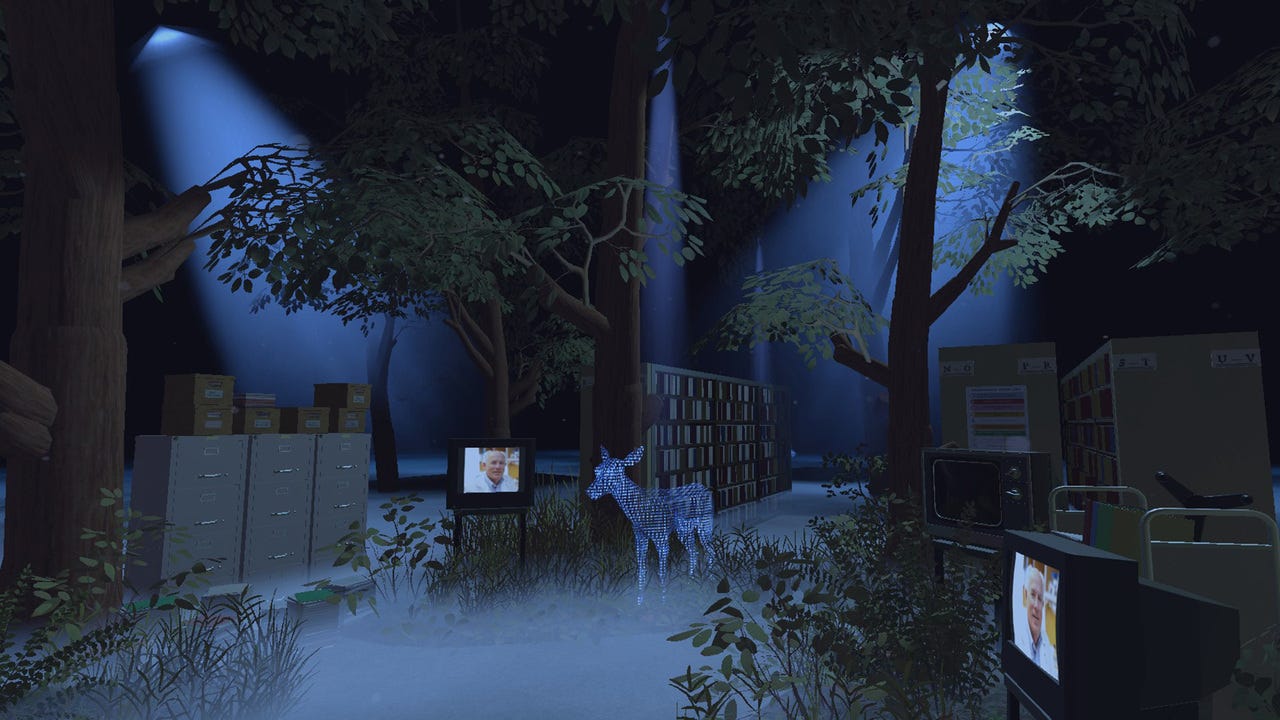
PLEASE BELIEVE ME
Nonny de la Peña; Kim Cleworth, Dan Brower, Charlie Park
28 min, VR (6DoF), Oculus App Lab
On-Site
Over the course of an almost 30 minute experience, I witness the tragic case of Vicki Logan, an American woman who sadly passed away from Lyme Disease. What makes this particular case so tragic is the years of misdiagnosis, unbelief, and insurance complications that plagued her tale. Presented in VR, this piece was a haunting highlight of the festival.
Told through vignettes, each scene contains recorded video of doctors, nurses and those who knew Vicki as they explain the details of her case. This is by far one of the most interactive VR pieces on display at this year’s Tribeca Festival, and I am asked not to walk around, but instead use the teleport function on my controller to move through the space. As I do, I am able to interact with documents and pictures as I learn more about this disease. At one point we zoom into the blood stream of Vicki, and witness the disease take over. To move on from each scene, a puzzle piece appears which once entered into its missing slot allows the piece to continue. Perhaps it feels a little forced, but the interaction is a nice way of showing the gradual piecing together of understanding that the doctors went through.
We hear and see Vicki herself through archival footage, and walking through a gallery of the photos of her family and loved ones is particularly hard hitting. It is a sharp reminder that this case existed, but more so that this woman had a real and lived experience. The injustice that her insurance company stopped paying for her care, which had proven to work, is made all the more real through this VR experience. Through her passing, more study has been able to be done on Lyme disease, and the piece ends on a hopeful note as we learn about the steps that science has been able to take to hopefully ensure that no one has to beg to be believed again.
Powerful and important work.— Edward Mylechreest
At Home
Confession time: although I love director Nonny de La Peña’s work, when I saw that her latest documentary piece was about Lyme disease I balked. Wasn’t the panic about Lyme Disease an overblown relic of the 1980’s? Was this really necessary in 2022 when we have bigger concerns with the health system to deal with?
Still: when I saw that Please Believe Me was part of the Tribeca collection being curated directly on the Quest (which itself isn’t that easy to find, which is something Meta would do well to correct) I decided to give it a go. After all, de la Peña doesn’t make bad work and it was right there.
To think that I nearly shrugged this off because of all the misinformation I’d absorbed about Lyme Disease over the years.
Please Believe Me lays out story of Vicki Logan, who contracted Lyme disease and never went fully into remission despite multiple courses of antibiotics, in exacting detail. The failures of our for-profit medical system and the way that bias and stigma, driven by the profit margins of health care companies, lead to misdiagnosis and indeed a general lethargy by the medical establishment when it comes to “difficult patients.”
Told through a series of interactive vignettes, embedded film clips, and still photos brought to life through “deep fake” technology, the methods de la Peña uses to convey the heartrending journey of Logan through her decline are just this side of miraculous. It plays out as a detective story of sorts, with the viewer cast in the role of investigative journalist. Essentially cast into the role of de la Peña herself.
What struck me most while witnessing this piece is the similarities between Lyme and the condition we know as “long Covid.” While one is the result of a bacterial infection hiding out in the body for years the other is less understood. Much in the way that Lyme was not understood and is still stigmatized in the popular discourse as my own ignorance, fueled by years of being “informed” by mainstream reportage, attests to. My great fear is that we’re about to see the Lyme story played out on a massive, global scale with the long term complications from Covid which is more pervasive, if somewhat more actively preventable than Lyme.
Once again de la Peña has created a timely piece that shifts the viewer’s perspective through he preponderance of the evidence and a meticulously crafted experience. This one is not to be missed. — Noah Nelson
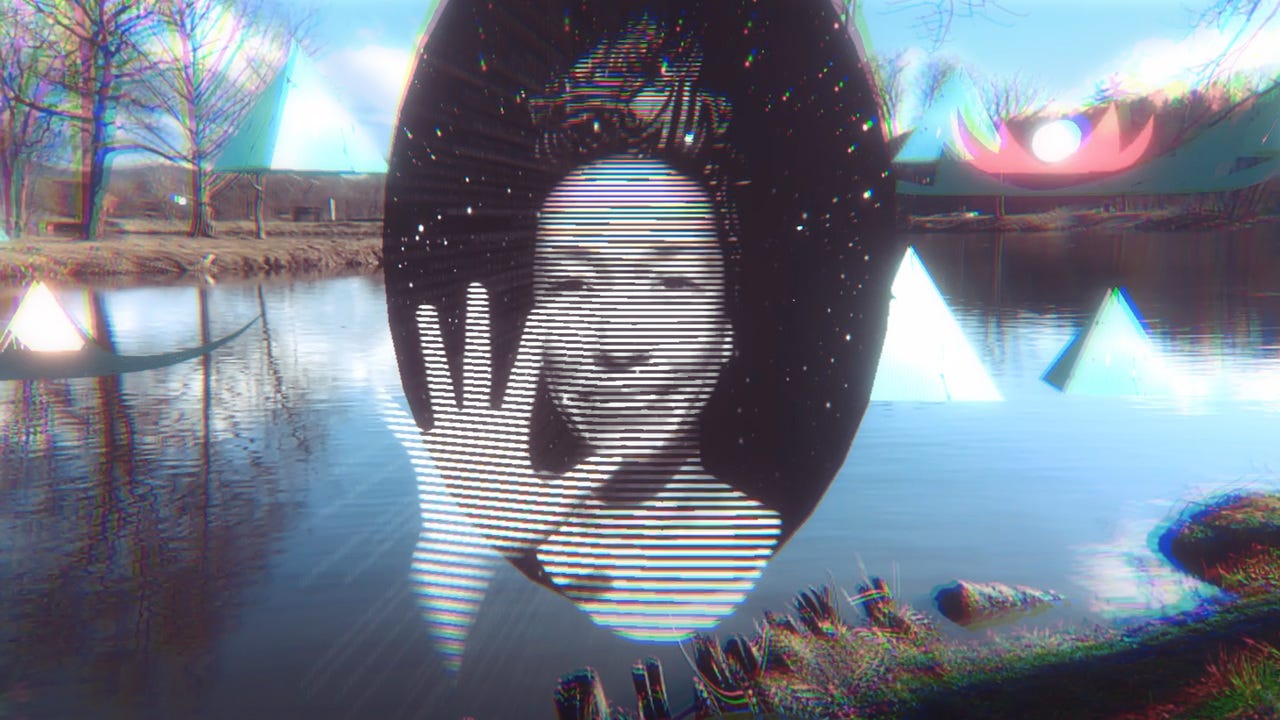
REACHYOUKatrina Goldsaito, Jonah Goldsaito
11 min, AR, On-Site
The future has been looking for you, it has an important message to deliver. Are you ready to accept it?
This simple premise is the basis for this lovely AR piece, involving a download to your Apple device (Android coming soon). I scan the floor, and the holographic head of a woman looks back at me through a portal. She looks at me calmly, and speaks to me softly, a far cry from the Great and terrible Wizard of Oz show that she reminds me of.
This transmission from the future is part of a series, that gently asks deep an meaningful questions about existence. I am asked to record my answers about what grief and joy look like in my life at the moment. This will then be recorded into the great transmission for all eternity to remember.
I am told that this app will be updated regularly, with new questions and content being added to the 10 minute experience. It’s a lovely little piece, which can act as a great way to showcase to those uninitiated the future of AR tech, and how it is being used right now. I am glad that this message finally found me.— Edward Mylechreest
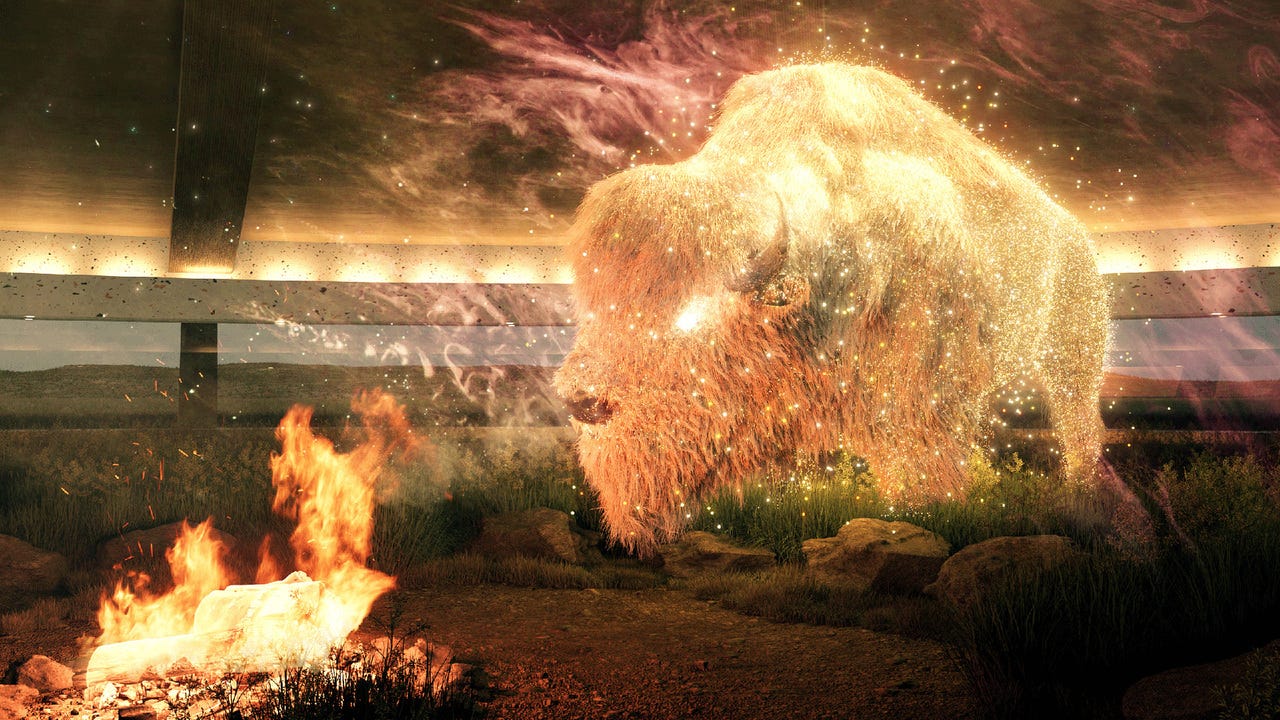
THIS IS NOT A CEREMONYAhnahktsipiitaa (Colin Van Loon); NFB (Dana Dansereau)
21 minutes, VR (3DoF), On-Site, Museum of Other Realities, Oculus TV
Combining CGI, 360 video, and traditional documentary interviews, This Is Not A Ceremony manages to be both very clever and profound in the same breath. Ahnahktsipiitaa (Colin Van Loon) calls on the audience to bear witness, in the Blackfoot tradition to two stories that form prime examples of the continued abuse of First Nations men at the hands of the systems built by those who colonized their lands. A raw bit of cultural memory that treads a narrow path between despair and anger and manages to come through it all conveying a sense of the strength of the community of which these men are a part.
Blending the different formats at hand could fall apart in less sure hands than Ahnahktsipiitaa’s but each element has its place and purposes, with the 360 video being used for re-enactments. The whole of the piece is framed within a large lodge space anchored by a central fire that the viewer, in fact, stands within as interviewee videos appear in the heavens above. Two young men act as dramatic chorus, framing the transitions and addressing the viewer directly at points. The overall effect is something akin to total documentary theatre, if there was such a thing.
There’s a dreamlike quality to the presentation, from the appearance of a CGI white buffalo at the start through graphical distortions in the 360 recreations that suggest the haze of memory. Collective memory, I should say. All the technique brought to bear manages to not be overly flashy and subsume the stories being told over the twenty plus minutes of the film. I’m not always sold on 360 video as a strong format in VR, I’ve seen it not work far often than I have seen it excel. Yet excel it does here, and while This Is Not A Ceremony very much shouldn’t be a template for others looking to make 360 docs, it is both far too specific of a piece and there would be a dark irony in ripping it off, there is much to be learned by students of the craft. This one is going to be with me for a while. — Noah Nelson
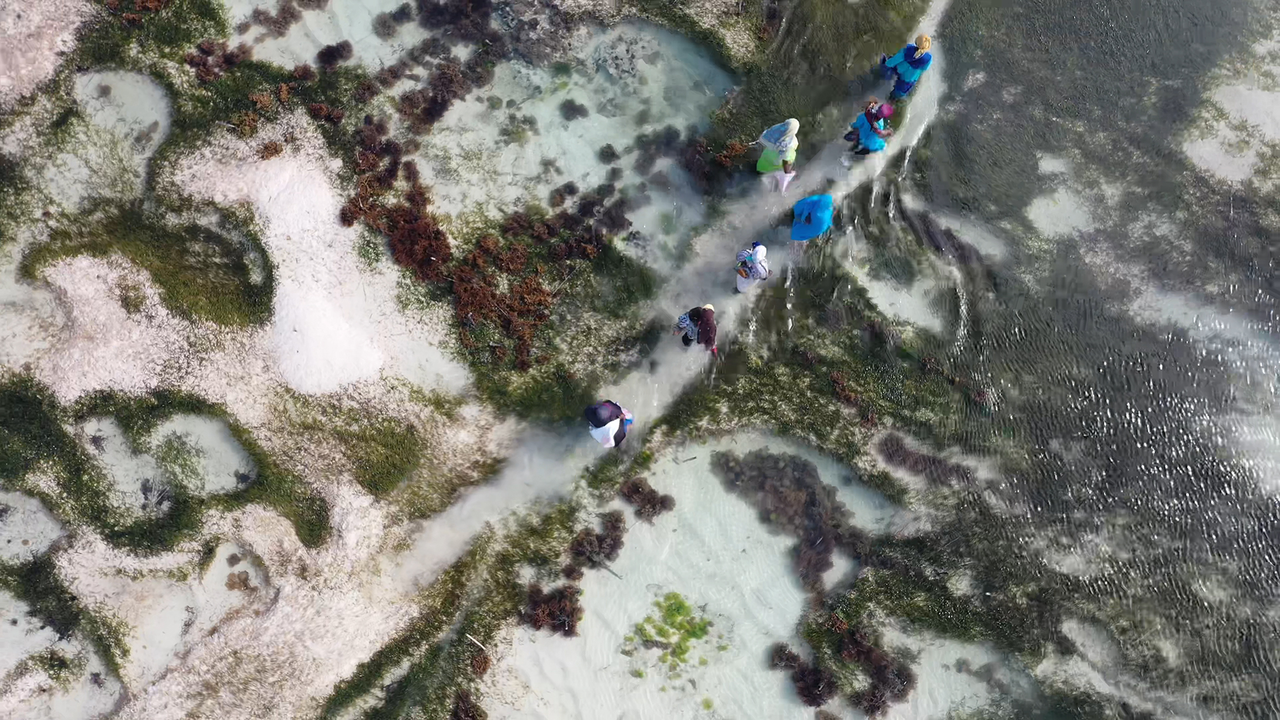
ZANZIBAR: TROUBLE IN PARADISEAshraki Mussa Machano, Steven-Charles Jaffe; Springbok Entertainment
10 min, Looking Glass 3D Video, On-Site
This short documentary tells the story of impoverished women in Zanzibar, seeking new work as they struggle against a male dominated society. The Seaweed crop has been effected by climate change, and no longer seems to be a suitable option. Instead the farming of sponges has become a new outlet for these women which offers them hope for the future.
I am handed headphones in order to listen to the movie, which does exactly that, but is not binaural or effected by my placement within the designated zone for the experience. However the screen I am watching the documentary on is quite special, in that it provides a holographic effect to the film. From a specific angle at least. If you are not in exactly the right spot, the image blurs and contorts in a way that is quite confusing to the eye. As a lifetime contacts user, i found myself reminded of the dreaded moment when a contact gets slightly misaligned in my eye. As a slightly taller than average audience member, I duck down slightly and find myself adjusting around, trying to keep the “correct” image in place.
It’s a touching documentary, but it’s inclusion in this years Immersive Tribeca festival seems baffling to me. I am told that most of the film was filmed on iPhones, and that the screen I am looking at is only 1 of 3 in the whole world. While this is impressive, the addition of this holographic screen added nothing to the documentary being presented, and had no connection ot the content that I could see. New technology is of course exciting, but the use here seems like a tacked on gimmick rather than a key to this story.— Edward Mylechreest
Discover the latest immersive events, festivals, workshops, and more at our new site EVERYTHING IMMERSIVE, new home of NoPro’s show listings.
NoPro is a labor of love made possible by our generous Patreon backers. Join them today!
In addition to the No Proscenium website, our podcast, and our newsletters, you can find NoPro on Twitter, Facebook, YouTube, Instagram, in the Facebook community Everything Immersive, and on our Discord.